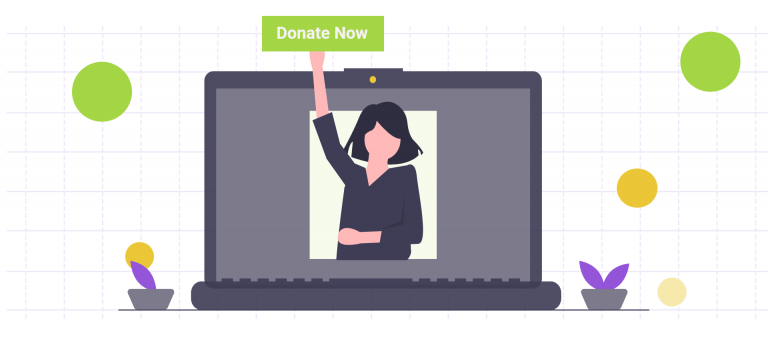15 Best Practices to Help You Write a Successful Fundraising Email

Thanks to the miracle of modern communication technology, there are so many tools available to a fundraiser wishing to contact their audience and ask for donations.
Between traditional methods like telephone calls and direct mail, and more high-tech options like social media and texting, communicating with donors is constantly becoming more sophisticated and eclectic. But above all other forms of nonprofit communication, there is one that reigns supreme: email.
With a little planning, a few lines of text, and a quick click of the send button, your emails can reach thousands of potential supporters in an instant. And people are willing to read them — email marketing from nonprofit organizations enjoys an average open rate of about 25%, which is excellent compared to other industries.
So if you’re interested in raising more money for your organization and looking for a tool that will give you a high percentage chance at success, consider developing a strategy that utilizes the power of fundraising emails. But don’t just type out the first thing that comes to mind—check out our best practices to ensure your fundraising emails find their target.
What is a Fundraising Email?
Also known as a fundraising appeal, a fundraising email is a message that is specifically crafted to solicit donations from existing and potential donors. A strategy based on fundraising emails also includes relevant planning, personalization, and categorization of contact lists to make fundraising emails more effective. All of which can be achieved most efficiently by using an email marketing tool.
Why Nonprofits Need to Send Fundraising Emails
For every 1,000 fundraising messages sent in 2020, nonprofits raised $78, which is a 35% increase from 2019, and it will likely continue to rise. Considering how inexpensive it is to send a thousand emails, this is an excellent return on investment and an easy way to boost your organization’s fundraising.
Why is email so effective? Emails find your supporters wherever they happen to be, from computers at the office and laptops at home to smartphones pretty much everywhere, and they feel more personal, especially when tailored to the specific needs of the recipient. Plus, with the right frequency, email can help you build an ongoing and meaningful relationship with your contacts, as you share impact stories, invite greater participation, and collect regular donations.
15 Fundraising Email Best Practices
Creating a great fundraising appeal isn’t as simple as typing out a casual message off the top of your head and clicking send. For your emails to be truly effective, be sure to follow these best practices that will help you write, design, target, and send your emails in just the right way for maximum impact.
1. Set a Goal
While raising money for your organization may be your ultimate goal, each fundraising email that you send should have specific objectives that allow you to focus your efforts and realize an outcome that is beneficial to your mission. So it’s important to set attainable, but ambitious, targets for your fundraising emails. For example:
- How much would you like to raise?
- What is your target open rate or click-through rate?
- How many new donors would you like to bring on board?
- How many major donations are you seeking?
Once you’ve set your goals, you can define key performance indicators (KPIs) that will help you achieve them.
2. Nail the Subject Line and Preview Text
Often the first part of your email that a recipient sees is the subject line, so it’s critical that you get it right to convince them to open your message. Use descriptive and action words to make your subject line compelling, while keeping it concise. If possible, use your email marketing platform to personalize the subject with your recipient’s name. For a push in the right direction, here are some great fundraising email subject lines to inspire you.
After the subject line, many email clients display preview text, which is a small amount of text intended to give recipients a hint at what the email is about. This is another important factor in getting potential donors to open your email. Various email clients handle preview text differently, so ensure that the first line of your email, as well as any alt-image text, is captivating enough to encourage your contacts to open your email and read the juicy goodness inside.
3. Include Fundraising CTAs
A call-to-action (CTA) is a phrase that you use to spur action in your recipients. Your fundraising email should contain just one compelling CTA that drives your audience to your donation page. In this case, it would be a donate button. The best CTAs are concise, urgent, and clear, hopefully eliminating any delay between reading your email and making a donation.
For some great tips and examples of excellent CTAs, check out this post from Firespring and this one from Constant Contact.
4. Tell Stories
When it comes to writing content, the most successful fundraising emails almost always include stories that highlight the positive impact their organizations make on the world. These types of stories communicate the value that donors offer to your cause, often outlining what specifically is being done with raised funds. There are lots of ways to tell impact stories, from straightforward text composition to multimedia and video, so feel free to get creative to capture the interest of your readers.
5. Send At The Optimal Times
Timing is everything when it comes to fundraising emails, so be sure you’re reaching out to your audience at times that are right for them, regardless of which time zone they live in. Generally speaking, it’s better to send emails on Tuesday, Wednesday, and Thursday during daytime hours.
A good email marketing tool will be able to help you organize and schedule your fundraising emails so they end up in inboxes at the best possible hour. And Keela Intelligence can help you determine the best time of year to send emails to donors.
6. Segment Your Donor List
Every great donor management strategy includes segmentation—hopefully your contacts are already tagged so they can be grouped according to the needs of your email fundraising campaign. If not, and if you’ve never even heard of segmentation, now is a great time to get started learning this important practice.
Donor segmentation is the process of grouping your contacts by common traits, like geographic location, income level, interests, giving habits, and more. These types of categories can help you personalize your fundraising emails so that they appeal to the recipients and trigger an emotional response that can help you collect more donations. Keela is a great way to easily segment your contact list based on your campaign preferences.
7. Use Branded Colours and Imagery
As with all things related to your organization, it’s a good idea to ensure consistent branding across the board, and that includes fundraising emails. Branding helps your audience to recognize and trust the communications that they receive from you, so be sure to use the right colors, logos, key phrases, and everything else your organization is known for. If you don’t have an existing email template equipped with your branding, Keela can help you build one.
8. Use Simple Formatting
Lots of organizations have someone with graphic design training on staff. And that person’s first impulse is going to be to create a beautiful design for your email. But instead of prioritizing beauty, focus on simplicity.
Most recipients won’t be able to tell if your design uses the golden ratio, but they will certainly fail to donate if they find your email confusing. So be sure to use high-contrast colors and strong layouts, avoid small text, and include images of real people rather than stock photos.
9. Include Suggested Donation Amounts
If you give a donor a blank field to enter their gift amount, you might get a huge donation, but you’re more likely to get five bucks. Instead, be sure that your fundraising email and donation page include suggested donation amounts that fit with your goals and KPIs.

10. Experiment with Emojis
Relative newcomers to the email scene, emojis could have a big impact on open rates. One study found that emails with subject lines that include emojis enjoyed a higher open rate than text-only subject lines. So experiment and see what works for your audience.
11. Focus on Your Fundraising Offer
Though it might be nice to update your audience on your latest staffing changes, invite them to follow you on social media, and encourage folks to volunteer, a fundraising email is not the place for it.
Keep the focus of your fundraising appeal on telling them what the campaign is going to do and asking for donations. If you can, give specific examples of what a donation will do (e.g. a $20 donation helps us plant 50 trees in the Amazonian rainforest).
12. Improve Deliverability and Avoid Spam
You can make all the content tweaks in the world, but if your emails aren’t reaching inboxes, your campaign is destined to fail. So don’t forget to check your sender reputation and work to improve it to avoid those pesky spam filters.
13. Perform A/B Tests
If you’re not sure if one of your tactics is going to work, don’t hesitate to create two versions of your email and see which one works better. This is called A/B testing and it’s great for figuring out which layouts work best, which subject lines have higher open rates, and which emails ultimately grab more donations.
14. Track Email Metrics
As with every type of campaign, measuring and recording data is the best way to understand what happened and make improvements for next time. It’s also a good idea to compile your data and conclusions in a fundraising report that is easy to share with staff, board members, and other stakeholders.
15. Use an Email Marketing Tool
If it wasn’t already obvious from the previous items on this list, an email marketing tool can make a lot of these tasks so much easier, saving your staff time and headaches and freeing them up to take on more human responsibilities. Our favorite? Keela of course. Not only does Keela offer a full-featured email marketing tool, but it also integrates it with a built-in CRM, smart tools, automated reporting, and much more.
Sample Fundraising Email
Now that you’ve got the basics under your belt, are you ready to see these tips in action? If so, check out our post on donation letters, which contains a sample fundraising email as well as some excellent templates to help set you up for success. Or you can download our ready-made templates to hit the ground running. You can do it!
.svg)




